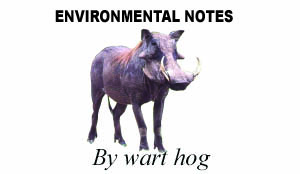 It is irrefutable that Zambia has some of the best policies in the world. The 1996 policy on education (‘educating our future’) for instance has been hailed as one of the vibrant national document to ever be formulated. In the environment sector, numerous policies have been developed.
It is irrefutable that Zambia has some of the best policies in the world. The 1996 policy on education (‘educating our future’) for instance has been hailed as one of the vibrant national document to ever be formulated. In the environment sector, numerous policies have been developed.
These include the National environment policy, Forestry Policy, Agriculture Policy to mention a few.
Legislations abound and they are superseded by the Environmental Management Act (EMA) no.12 of 2011. The abounding professionally crafted national documents still begs the question, for whom are the documents developed? How much are people at grassroots level informed of these policies? The Wildlife and Environmental Conservation Society of Zambia (WECSZ) with kind support from the Critical Ecosystem Partnership Fund (CEPF) has made strides in sensitising grassroot communities on environmental policies and legislations in the country.
WECSZ recently organised a policy awareness workshop in Isoka. Among the delegates were chief Mwenewisi and chief Mwenenchifungwe of Mafinga district.
The workshop was aimed at informing the traditional and civic leadership of Mafinga district on various policies and legislations governing national biodiversity and how they apply to their local setting.
The workshop brought together communities and strategic government institutions to share policies and legislations governing the afromontane biodiversity of Mafinga District.
This came in the wake of the realisation that national policies have rarely trickled down to the local people especially those residing in rural areas.
This could partly be attributed to the fact that such areas are remote and have limited access to the media. Mafinga district for instance has not yet been connected to the national electricity grid. Television and radio reception in the district is intermittent which makes it hard for people to have access to local news.
People in rural and peri-urban areas are fondly referred to as ‘people at grassroots level’. These are the people who live with and protect our natural resources. They are in constant interaction with resources at the lowest level.
It is a known fact that critical to the successful implementation of the policies is the involvement of implementers, people at the grassroot level, in the formulation process.
This allows the implementers to fully appreciate the content and value of the policies and ensures effective implementation.
Prior to the workshop, the team sought to find out from the community what local rules were governing biodiversity resources in the area.
The meeting brought out one important understanding: the communities have traditional rules that have for many years protected biodiversity. These rules are however subject to particular chiefdoms and vary from chiefdom to chiefdom. In Mwenewisi chiefdom for instance, burning (whether early or late burning) of bushes is prohibited while Mwenechifungwe chiefdom allows for early burning as a good agricultural practise.
At national level, we have a number of environmental policies governing the biodiversity management. Awareness of such policies among grassroot communities was the issue which brought all the experts from the Department of Forestry, Department of Agricultural, National Heritage Conservation Commission and the Ministry of Lands, Natural Resource and Environmental Protection.
Each expert at the workshop gave an easy to understand, simplified presentation on the policies concerned with each sector.
They also highlighted the roles and responsibilities they carry in protection of biodiversity in Zambia.
So why do we need policies and legislations in the environment sector? History teaches us people have a tendency to abuse resources which are considered to be public or common. Rivers such as the Kafue on the Copperbelt have been repeatedly polluted by mining companies.
The Luangwa and Chongwe rivers in Muchinga, Eastern and Lusaka provinces are drying partly due to unsustainable practices of water abstraction and agriculture along the riparian zones.
If left without guiding rules in form of policies and accompanying legislations, we would lose a lot of our biodiversity, not just rivers but a lot more other resources such as timber resources and wildlife. One popular approach of looking at the pressure heaped on ecosystem resources is expressed in a popular a theory known as the ‘tragedy of the commons’.
According to this theory, people –acting independently according to their own self-interest and contrary to the common good –tend to maximise their benefit from a shared-resource (common resource). Such maximisation gradually inflates the demand for the given resource and eventually creates an overwhelming pressure on the sustainability of the resource. If left unchecked, the resource becomes depleted and may no longer be available to anyone –hence the tragedy of the commons.
It is no wonder that policies are developed. If you appreciate the state of our environment, you will agree that there are many things that need our attention for protection. Granted, the increasing population in the country makes it ever more difficult to address biodiversity loss. But there are several important ways in which we can slow down biodiversity loss, and sometimes it may call for restocking of animals in isolated cases.
The English say ‘an ounce of prevention is worth a pound of cure’. Well it is common knowledge that preventing a problem from developing in the first place is often much easier and less expensive than to try to fix it once damage occurs. Policies and environmental legislations are ideal to help prevent damage to the environment.
It is a known fact that education is a powerful tool in shaping behaviour and invoking feelings of concern for the environment.
The more people are informed about biodiversity and legislations governing the utilisation and management thereof, the more they will be prepared to help protect biodiversity.
Comments: Wildlife & Environmental Conservation Society of Zambia, P.O. Box 30255, Lusaka, Zambia. Telefax: 260-211-251630, Cell: 0977-780770, E-mail: wecsz@coppernet.zmFacebook: Wildlife and Environmental Conservation Society of Zambia.






